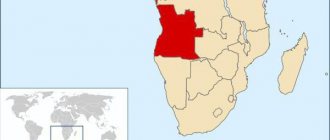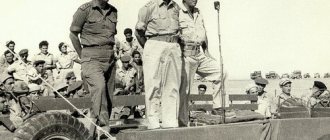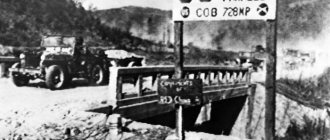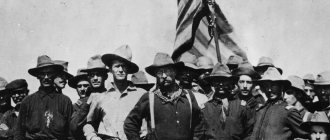Prerequisites for the conflict
Since the 17th century, England began the gradual seizure and subjugation of states located on the Indian subcontinent. As a result, by the mid-19th century, India became a colony of the British Empire, and the inhabitants of India became subjects of the British crown.
India in the 20th century. mass protests against the British authorities took hold, and the difficult economic situation in the country intensified protest sentiments. For Great Britain, in the changed post-war world, it was important to maintain an economic presence in its colonies, and therefore political withdrawal from India was a guarantee of the continued preservation of its own economic presence there.
Are you an expert in this subject area? We invite you to become the author of the Directory Working Conditions
The largest political forces in India were the Indian National Congress (INC) and the Muslim League (ML). The INC was committed to the idea of all-Indian secular nationalism and secular statehood, and defended the idea of a united and indivisible India after the country was granted independence. The Muslim League (ML), in turn, since 1940, followed the course of creating a state of Indian Muslims - Pakistan.
The result was strained relations between the Hindu and Muslim communities in India. A wave of pogroms swept across the country.
Other Hindu political parties also became active. These include, first of all, the Hindu Mahasabha (HMC, Great Hindu Alliance), which defended the idea of a “Hindu Rashtra” (Hindu state), and religious organizations adjacent to them, such as the Rashtriya Swayam Sevak Sangh (RSS, Union of Voluntary Servicemen of the Motherland), which spoke for the revival of Hindu values.
The situation began to escalate and get out of the control of the British authorities.
Britain pledged after World War II to grant independence to its richest colony.
Finished works on a similar topic
Coursework Indo-Pakistani wars 400 ₽ Essay Indo-Pakistani wars 250 ₽ Test paper Indo-Pakistan wars 250 ₽
Receive completed work or specialist advice on your educational project Find out the cost
In 1945-1947, active negotiations began between the leading political players in Great Britain and India. During the negotiations, some Indian princes demanded independence for their domains. As a result, the national forces of India faced two serious issues - the question of division into two dominions on religious grounds and the question of the status of the princely states.
Note 1
The Indian National Congress was forced to agree to the division of India into two states and the creation of Pakistan. In exchange, the INC obtained British consent to renounce the principle of “supremacy” in relation to the princely states and accept the Congress strategy regarding the fate of the princes.
As a result of disagreement among the political forces of the country and the unprecedented scale of discord between religious communities, fearing the disintegration of the country into dozens of political entities at war with each other, it was decided to consider, including representatives of the INC, the division of the country into two parts as an acceptable way out of the current situation.
In July 1947, the Mountbatten Plan was published. According to this plan, India was to be divided into two dominions:
- Indian Union,
- Pakistan.
The disputed provinces of Bengal and Punjab were to be divided along religious lines.
In August 1947, the British Parliament approved the Mountbatten Plan as the Indian Independence Act. The country entered a new period: on the site of the colony of British India, on the night of August 14-15, two self-governing dominions emerged - the Indian Union and Pakistan.
Nevertheless, about 45 million Muslims remained in India. Most of them were scattered throughout India, but there were several pockets of concentration of the Muslim population. However, the Muslim minority in India, like the Hindu minority in Pakistan, had no opportunity to claim autonomy or secession.
Particular tension arose in the princely states of Jammu and Kashmir, where there was a high Muslim population.
According to the decision to join India, Jammu and Kashmir would receive special autonomy and the question of their future would remain open. However, events turned out differently.
Wars of the 21st Century: India vs Pakistan
"SP" continues to analyze modern conflict situations in the world that can lead to large-scale wars. Today we will talk about more than 60 years of Indo-Pakistani confrontation, which in the 21st century was aggravated by the fact that both states have developed (or received from their patrons) nuclear weapons and are actively increasing their military power.
A threat to everyone
The Indo-Pakistani military conflict occupies, perhaps, the most ominous place in the list of modern threats to humanity. According to Russian Foreign Ministry official Alexander Shilin, “the confrontation between these two states became particularly explosive when both India and Pakistan, having conducted a series of nuclear tests, demonstrated their ability to create nuclear weapons. Thus, the South Asian military confrontation became the second hotbed of nuclear deterrence in world history (after the Cold War between the USSR and the USA).”
This is compounded by the fact that neither India nor Pakistan have signed the Nuclear Non-Proliferation Treaty and continue to refrain from joining it. They consider this treaty discriminatory, that is, it secures the right to possess nuclear weapons to a small group of “privileged” countries and cuts off all other states from the right to ensure their own security by all available means. Accurate data on the nuclear capabilities of the armed forces of India and Pakistan are not published in the open press. According to some estimates, both states have set a goal (and perhaps have already achieved it) to increase the number of nuclear weapons from 80 to 200 on each side. If they are used, this is enough for an environmental disaster to cast doubt on the survival of all humanity. The causes of the conflict and the ferocity with which it is developing indicate that such a threat is very real.
History of the conflict
As you know, India and Pakistan were part of the British colony of India until 1947. In the 17th century, Great Britain took the feudal principalities that existed here “under its wing” with fire and sword. They were inhabited by numerous nationalities, which could be roughly divided into Hindus themselves - the indigenous inhabitants of the country and Muslims - the descendants of the Persians who conquered India in the 12th-13th centuries. All these peoples lived relatively peacefully with each other. However, Hindus were concentrated mainly in what is now India, and Muslims were concentrated in what is now Pakistan. In the lands that now belong to Bangladesh, the population was mixed. A significant part of it consisted of Bengals - Hindus professing Islam.
Britain brought turmoil into the relatively peaceful life of the tribes. Following the old and proven principle of “divide and rule,” the British pursued a policy of dividing the population along religious lines. Nevertheless, the constantly ongoing national liberation struggle here led to the formation of independent states after the Second World War. Northwestern Punjab, Sindh, North-Western Province, and Baluchistan were ceded to Pakistan. This was indisputable, since these lands were inhabited by Muslims. A separate region became part of the previously divided Bengal - East Bengal or East Pakistan. This enclave could communicate with the rest of Pakistan only through Indian territory or by sea, but this required traveling more than three thousand miles. This division has already created a source of tension between the two countries, but the main problem is the situation with the princely states of Jammu and Kashmir.
In the Kashmir Valley, 9 out of ten people professed Islam. At the same time, historically it turned out that the entire ruling elite consisted of Hindus, who naturally wanted to incorporate the principality into India. Naturally, Muslims did not agree with this prospect. Spontaneous militia groups began to be created in Kashmir, and groups of armed Pashtuns began to infiltrate from the territory of Pakistan. On October 25, they entered the capital of the princely state, Srinagar. Two days later, Indian troops retook Srinagar and drove the rebels away from the city. The Pakistani government also sent regular troops into the battle. At the same time, repressions against people of other faiths took place in both countries. Thus began the first Indo-Pakistani war.
Artillery was widely used in the bloody battles, and armored units and aviation took part. By the summer of 1948, the Pakistani army occupied the northern part of Kashmir. On August 13, the UN Security Council adopted a resolution calling for a ceasefire by both sides, but it was not until July 27, 1949 that Pakistan and India signed an armistice. Kashmir was divided into two parts. For this, both sides paid a terrible price - more than a million killed and 17 million refugees.
On May 17, 1965, the 1949 truce was violated, as many historians believe, by India: a battalion of Indian infantry crossed the ceasefire line in Kashmir and fought to take several Pakistani border posts. On September 1, regular units of the Pakistani and Indian armies in Kashmir entered into combat contact. The Pakistani Air Force began to strike major cities and industrial centers in India. Both countries actively carried out airborne troops. It is unknown how all this would have ended if not for the strong diplomatic pressure that forced Delhi to end the war. The Soviet Union, India's long-standing and traditional ally, was irritated by Delhi's military adventure. The Kremlin, not without reason, feared that China might enter the war on the side of its ally Pakistan. If this happened, the US would support India; then the USSR would have been relegated to the background, and its influence in the region would have been undermined.
At the request of Alexey Kosygin
then
Egyptian President Nasser
personally flew to Delhi and criticized the Indian government for violating the ceasefire agreement. On September 17, the Soviet government invited both sides to meet in Tashkent and resolve the conflict peacefully. On January 4, 1966, Indo-Pakistani negotiations began in the Uzbek capital. After much debate, on January 10 it was decided to withdraw troops to the pre-war line and restore the status quo.
Neither India nor Pakistan were happy with the “pacification”: each side considered its victory stolen. Indian generals stated that if the USSR had not intervened, they would have been sitting in Islamabad for a long time. And their Pakistani colleagues argued that if they had another week, they would have blocked the Indians in southern Kashmir and made a tank attack on Delhi. Soon both of them again had the opportunity to measure their strength.
It began with the fact that on November 12, 1970, a typhoon swept over Bengal, claiming about three hundred thousand lives. The colossal destruction further deteriorated the living standards of the Bengalis. They blamed the Pakistani authorities for their plight and demanded autonomy. Islamabad sent troops there instead of helping. It was not a war that began, but a massacre: the first Bengalis who came across were crushed by tanks, grabbed in the streets and taken to a lake in the vicinity of Chittagong, where tens of thousands of people were shot with machine guns, and their bodies were drowned in the lake. Now this lake is called the Lake of the Risen. Mass emigration to India began, where about 10 million people ended up. India began to provide military assistance to rebel groups. This eventually led to a new India-Pakistan war.
The main theater of hostilities was Bengal, where the navies of both sides played a crucial role in conducting operations: after all, this Pakistani enclave could only be supplied by sea. Considering the overwhelming power of the Indian Navy - an aircraft carrier, 2 cruisers, 17 destroyers and frigates, 4 submarines, while the Pakistani fleet included a cruiser, 7 destroyers and frigates and 4 submarines - the outcome of events was a foregone conclusion. The most important result of the war was the loss of Pakistan's enclave: East Pakistan became the independent state of Bangladesh.
The decades following this war were rich in new conflicts. It was particularly acute at the end of 2008 and beginning of 2009, when the Indian city of Mumbai was attacked by terrorists. At the same time, Pakistan refused to extradite to India those suspected of involvement in this action.
Nowadays, India and Pakistan continue to teeter on the brink of open war, and Indian authorities have stated that the fourth Indo-Pakistani war should be the last.
Silence before the explosion?
First Vice-President of the Academy of Geopolitical Problems, Doctor of Military Sciences Konstantin Sivkov
in a conversation with a SP correspondent, he commented on the situation in modern relations between India and Pakistan:
— In my opinion, at the moment the Indo-Pakistani military conflict is at the bottom point of a conditional sine wave. The leadership of Pakistan today is solving the difficult task of resisting pressure from Islamic fundamentalists, who find support in the depths of Pakistani society. In this regard, the conflict with India faded into the background. But the confrontation between Islam and the Pakistani authorities is very typical of the current world situation. The Pakistani government is pro-American to the core. And the Islamists who are fighting against the Americans in Afghanistan and striking their proxies in Pakistan represent the other side - objectively, so to speak, anti-imperialist.
As for India, it has no time for Pakistan now either. She sees where the world is heading and is seriously busy rearming her army. Including modern Russian military equipment, which, by the way, almost never reaches our troops.
“SP”: — Who is she arming herself against?
— It is clear that the United States may sooner or later instigate a war with Pakistan. A long-standing conflict is fertile ground for this. In addition, the current NATO war in Afghanistan may provoke the next round of Indo-Pakistani military confrontation. The fact is that while it is going on, the United States has supplied Afghanistan (and therefore, indirectly, the Pakistani Taliban) with a huge amount of ground weapons, the return of which back to the United States is an economically unprofitable operation. This weapon is destined to be used, and it will fire. The Indian leadership understands this. And he is preparing for such a course of events. But the current rearmament of the Indian army, in my opinion, also has a more global goal.
"SP": - What are you talking about?
— In an interview with Free Press, I have more than once drawn attention to the fact that the world with catastrophic acceleration is rushing towards the beginning of the “hot” period of the next world war. This is due to the fact that the global economic crisis is not over, and it can only be resolved by building a new world order. And there has never been a case in history where a new world order was built without bloodshed. Events in North Africa and other countries are a prologue, the first sounds of the coming world war. The Americans are at the head of the new redivision of the world. Today we are witnessing an almost fully formed military coalition of US satellites (Europe plus Canada). But the coalition opposing it is still just being formed. In my opinion, it has two components. The first is the BRICS countries (Brazil, Russia, India, China, South Africa). The second component is the countries of the Arab world. They are just beginning to realize the need to create a unified defense space. But the processes are moving quickly. The Indian leadership is perhaps responding most adequately to ominous changes in the world. It seems to me that it soberly looks into the more or less distant future, when the formed anti-American coalition will still have to face the main enemy. In India, there is a real reform of the army, not like ours.
Disappointing calculations
Alexander Shilov, an employee of one of the departments of the Russian Foreign Ministry, has a slightly different opinion
— It is clear that India’s nuclear deterrence is directed primarily against those states that it considers likely adversaries. First of all, this is Pakistan, which, like India, is taking measures to form strategic nuclear forces. But the potential threat from China has been a major factor influencing India's military planning for many years. Suffice it to recall that the Indian nuclear military program itself, the beginning of which dates back to the mid-60s, was mainly a response to the emergence of nuclear weapons in the PRC (1964), especially since China inflicted a heavy defeat on India in the border war in 1962 . To contain Pakistan, India will likely only need a few dozen warheads. According to Indian experts, the minimum in this case would be a potential that would ensure the survival of 25-30 ammunition carriers after the first surprise nuclear strike from Pakistan. Considering the size of India's territory and the ability to significantly disperse nuclear attack weapons, it can be assumed that a strike from Pakistan, even the most massive one, will not be able to disable the majority of Indian strategic nuclear forces. An Indian retaliatory strike using at least 15-20 nuclear warheads will undoubtedly lead to irreparable damage up to and including the complete collapse of the Pakistani economy, especially since the range of Indian aviation and the ballistic missiles being developed by Delhi allows them to hit virtually any object in Pakistan. Therefore, if we keep in mind only Pakistan, an arsenal of 70-80 ammunition may apparently be more than enough. To be fair, it should be noted that the Indian economy will hardly be able to withstand a nuclear strike using at least 20-30 charges from the same Pakistan.
However, if we proceed simultaneously from the principle of causing unacceptable damage and not using nuclear weapons first, then in the case of China it will be necessary to have an arsenal at least comparable to the Chinese one, and Beijing currently has 410 charges, of which no more than 40 are on intercontinental ballistic missiles. It is clear that if we count on a first strike from China, then Beijing is able to disable a very significant part of India’s nuclear attack weapons. Thus, their total number should be approximately comparable to the Chinese arsenal and reach several hundred in order to ensure the required survival rate.
As for Pakistan, the leadership of this country constantly makes it clear that the threshold for the possible use of nuclear weapons by Islamabad may be very low. At the same time (unlike India), Islamabad apparently intends to proceed from the possibility of using its nuclear weapons first. Thus, according to Pakistani analyst Lieutenant General S. Lodi,
“If a dangerous situation arises where an Indian conventional offensive threatens to breach our defenses, or has already achieved a breakthrough that cannot be eliminated by conventional measures at our disposal, the Government will have no other option but to use our nuclear weapons to stabilize the situation."
In addition, according to a number of statements by the Pakistanis, as a countermeasure in the event of a massive offensive by Indian ground forces, nuclear landmines could be used to mine the border zone with India.
From the "SP" dossier
Indian Armed Forces
India's regular armed forces number 1.303 million (the fourth largest force in the world). Reserve 535 thousand people.
The ground forces (980 thousand people) form the basis of the armed forces. The ground forces are armed with: five OTR “Prithvi” launchers; 3,414 battle tanks (T-55, T-72M1, Arjun, Vijayanta); 4,175 field artillery guns (155 mm FH-77B Bofors howitzers, 152 mm howitzers, 130 mm M46 guns, 122 mm D-30 howitzers, 105 mm Abbot self-propelled howitzers, 105 mm IFG howitzers Mk I/II and M56, 75-mm RKU M48 guns); more than 1,200 mortars (160-mm Tampella M58, 120-mm Brandt AM50, 81-mm L16A1 and E1), about 100 122-mm MLRS BM-21 and ZRAR; ATGM “Milan”, “Malyutka”, “Bassoon”, “Competition”; 1,500 recoilless rifles (106 mm M40A1, 57 mm M18); 1,350 BMP-1/-2; 157 armored personnel carrier OT62/64; over 100 BRDM-2; SAM systems "Kvadrat", "OSA-AKM" and "Strela-1"; ZRPK "Tunguska", as well as MANPADS "Igla", "Str-la-2". In addition, there are 2,400 anti-aircraft artillery installations of 40 mm L40/60, L40/70, 30 mm 2S6, 23 mm ZU-23−2, ZSU-23−4 "Shil-ka", 20 mm cannon " Oerlikon"; 160 multi-purpose Chitak helicopters. Some armored vehicles and artillery systems are in storage.
The Air Force (150 thousand people) is armed with 774 combat and 295 auxiliary aircraft. Fighter-bomber aviation includes 367 aircraft, consolidated into 18 aircraft (one Su-30K, three MiG-23, four Jaguars, six MiG-27, four MiG-21). The fighter aviation consists of 368 aircraft, grouped into 20 aviation units (14 MiG-21, one MiG-23MF and UM, three MiG-29, two Mirage-2000), as well as eight Su-30MK aircraft. Reconnaissance aviation has one squadron of Canberra aircraft (eight aircraft) and one MiG-25R (six), as well as two MiG-25U, Boeing 707 and Boeing 737 aircraft each. Electronic warfare aviation includes four Canberra aircraft and four helicopter HS 748. Transport aviation is armed with 212 aircraft, united in 13 squadrons (six An-32, but two Vo-228, BAe-748 and Il-76), as well as two Boeing 737-200 aircraft and seven BAe-748 aircraft. 748. In addition, the aviation units are armed with 28 BAe-748, 120 Kiran-1, 56 Kiran-2, 38 Hunter (20 P-56, 18 T-66), 14 Jaguar, nine MiG -29UB, 44 TS-11 Iskra and 88 NRT-32 trainers. Helicopter aviation includes 36 attack helicopters, grouped into three squadrons Mi-25 and Mi-35, as well as 159 transport and transport-combat helicopters Mi-8, Mi-17, Mi-26 and Chitak, grouped into 11 squadrons. The air defense forces are organized into 38 squadrons. In service are: 280 launchers of the S-75 “Dvina” air defense system, S-125 “Pechora”. In addition, to increase the combat capabilities of air defense, the command plans to purchase S-300PMU and Buk-M1 anti-aircraft missile systems from Russia.
The naval forces (55 thousand people, including 5 thousand naval aviation, 1.2 thousand marine infantry) include 18 submarines, the aircraft carrier Viraat, Delhi-class destroyers, Project 61ME, frigates of the Godavari and Linder type, corvettes of the Khukri type (Project 25), Petya 3 (Project 159A). The naval aviation is armed with 23 Sea Harrier attack aircraft (two squadrons); 70 anti-submarine helicopters (six squadrons): 24 Chitak, seven Ka-25, 14 Ka-28, 25 Sea King; three squadrons of basic patrol aircraft (five Il-38, eight Tu-142M, 19 Do-228, 18 BN-2 Defender), a communications squadron (ten Do-228 and three Chetak), a rescue helicopter squadron (six Sea King helicopters), two training squadrons (six HJT-16, eight NRT-32, two Chitak and four Hughes 300 helicopters).
Pakistan Armed Forces
The number of military personnel is 587,000, mobilization resources are 33.5 million people.
Ground forces - 520,000 people. Armament: 18 OTR “Hagf”, “Shakhinya”, more than 2320 tanks (M47. M48A5, T-55, T-59, 300 T-80UD), 850 M113 armored personnel carriers, 1590 PA guns, 240 self-propelled guns, 800 ATGM launchers, 45 RSEO, 725 mortars, more than 2000 ZA guns, 350 MANPADS (Stinger, Red Eye, RBS-70), 500 Anza MANPADS, 175 aircraft and 134 AA helicopters (of which 20 attack AH-1F).
Air Force - 45,000 people. Airplane and helicopter fleet: 86 Mirage (ZER, 3DP, 3RP, 5PA. RA2, DPA, DPA2), 49 Q-5, 32 F-16 (A and B), 88 J-6, 30 JJ-5, 38 J-7, 40 MFI-17B, 6 MIG-15UTI, 10 T-ZZA, 44 T-37(ViS), 18K-8, 4 Atlangik, 3 R-ZS, 12 S-130 (B and E ), L-100, 2 Boeing 707, 3 Falcon-20, 2 F.27−200, 12 CJ-6A, 6 SA-319, 12 SA-316, 4 SA-321, 12 SA-315B.
Navy - 22,000 people. (including 1,200 in MP and about 2,000 in the Maritime Security Agency). Ship's complement: 10 GSh (1 "Agosta-90V", 2 "Ago-sta", 4 "Daphne", etc.), 3 SMPL MG 110, b FR URO "Amazon", 2 FR "Linder", 5 RKA ( 1 "Japalat", 4 "^anfeng"), 4 PKA (1 "Lar-kana", 2 "Shanghai-2", 1 "Town"), 3 MTK "Eridan", 1 GISU 6 TN. 3 Naval Aviation: Aircraft - 1 air force (3 R-ZS, 5 F-27, 4 "Aglantik-1"); helicopters - 2 airborne submarines (2 Linyu HAS.3.6 Sea King Mk45, 4 SA-319B).
First Indo-Pakistani War
The first clash between India and Pakistan began with the invasion of Kashmir by Pashtun tribes allied to Pakistan in early 1948. This invasion led its Hindu ruler, Maharajah Hai Singh, to announce the annexation of the princely state to India. Pakistani and Indian troops entered the lands of the principality. The fighting was stopped through UN mediation in January 1949.
First India-Pakistan War 1947-1948 ended with the establishment of a demarcation line on January 1, 1949. It divided the former principality into territories controlled by India (they made up about 60% of Jammu and Kashmir and were included in the state of the same name with the capital in Srinagar, with a special status assigned to it in the country’s constitution), and territories controlled by Pakistan - Azad Kashmir ( Free Kashmir) with its center in Muzaffarabad, as well as the so-called Northern Territories with its center in Gilgit.
Mountbatten Plan
The division of territories between the two new states was carried out according to the "3 June Plan", also known as the Mountbatten Plan.
The border was called the “Radcliffe Line” and was determined based on the data of the report of the British government commission. Pakistan, populated predominantly by Muslims, consisted of two unconnected enclaves:
- East Pakistan (now Bangladesh);
- West Pakistan (now Pakistan proper).
Are you an expert in this subject area?
We invite you to become the author of the Directory Working Conditions Between them lay India, populated predominantly by Hindus.
To complete the formal partition, the Indian Independence Act was passed by the British Parliament on July 18, 1947. By introducing amendments to the Administration of India Act of 1935, the legal basis for the creation and existence of two new dominions was created. A sovereign Pakistan was to become a new member of the UN. The Indian Union, created from Hindu states, took the name India, and automatically inherited the place of British India in the UN.
Note 1
625 principalities were given the opportunity to choose which country to join.
Second Indo-Pakistani War
The Second Indo-Pakistani War occurred in August–September 1965.
Back in April, an artillery exchange began in the mountainous region of Rann Kutch, which was under Indian control. Gradually, the conflict, either fading or flaring up, broke out in Kashmir. Large-scale hostilities began.
On September 23, 1965, a ceasefire was held. Later, an agreement was concluded to transfer the Rann-Kutch sector to Pakistan and the territory near the city of Sialkot to India.
Note 2
The Soviet Union mediated between India and Pakistan, and with its help, in January 1966, Pakistani President Ayub Khan and Indian Prime Minister Shastri signed the Tashkent Declaration, which ended the war.
The conflict between India and Pakistan ended without a convincing victory for either side. At the same time, in both Pakistan and India, state propaganda spoke of a successful end to the war for their country.
Mass migrations of people
Immediately after gaining independence, the two states began a massive “population exchange” that lasted several months. More than 14.5 million people crossed the new official borders in hopes of finding safety among fellow believers. The 1951 Census of Displaced Persons shows that after partition, 7.22 million Muslims moved from India to Pakistan, while 7.24 Hindus and Sikhs moved in the opposite direction.
The newly created governments were unprepared for such large-scale migrations, which led to mass violence on both sides of the border. Various sources estimate the number of victims from 200 thousand to about 1 million).
Punjab
In 1947, the British Indian province of Punjab was divided between India and Pakistan. The Muslim-majority western part became the Pakistani province of Punjab, and the Hindu-populated eastern part became the Indian state of Punjab. Since many Hindus lived in the west, and many Muslims in the east, during the partition there was a massive migration, accompanied by bloody clashes. At the center of the conflict were Lahore and Amritsar, which, by decision of the British, became part of Pakistan, but due to insufficient border control, Amritsar became part of India, and Lahore became part of Pakistan.
Bengal
The province of Bengal was also divided into two parts. West Bengal became part of India and East Bengal became part of Pakistan. In 1955, East Bengal gained independence under the name Bangladesh.
Sindh
Sindh has long had good relations between Muslims and Hindus. It was believed that the Hindus, who numbered about 1.4 million, would be able to stay there after partition. However, within a year, 1.2 million people left their homeland and went to India. The reason for this was the increasing attacks on Hindu houses by Muslim migrants.











